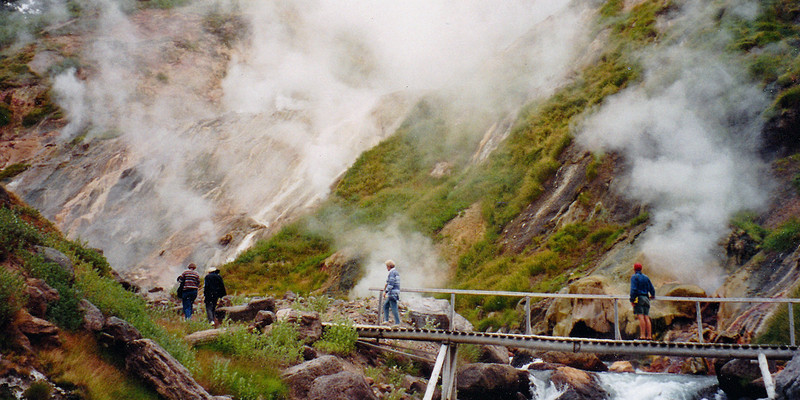Geysers, Mud and the Bear Man
Kamchatka, Russia, 1993
by Lynda Gordon

Back in 1993, tourism in the far north-east of Russia was non-existent. The area was a major base for nuclear submarines and most definitely not open to foreign visitors. The small expedition ship on which I would be travelling for the next few weeks (the Caledonian Star) was, I learned, the first ever foreign passenger ship to visit Petropavlovsk, the main town of Kamchatka, a wild, remote and sparsely inhabited peninsula in the far north-east of Russia.
With a day in hand before the start of the voyage, I and a number of others were offered the opportunity to take an unscheduled helicopter excursion to the Valley of Geysers, hidden in a deep, remote part of Kamchatka’s wild mountainous interior. This valley was discovered only in 1941 but little exploration of the area took place until 1972. Getting there necessitated a helicopter flight over tundra, forested hills, rivers and several active volcanoes. As we progressed farther and farther from the coast, patches of snow began to appear on the mountain tops. The helicopter flew low to allow its passengers close views of this vast untouched wilderness.
One and a quarter hours later, we landed in a meadow full of wild flowers and surrounded by high green hills. We walked across the meadow, then down over rough ground into the deep, steam-filled canyon. Geysers were spurting their steaming water out of an assortment of craters and fissures on the sides and foot of the canyon. One geyser erupted directly in front of me, flinging its stream of white water high into the sky in a cloud of steam, before quietening down into a docile bubbling. I learned later that this valley has the second largest concentration of geysers in the world.
The sounds of the valley hissing and spluttering were mingled with the glurping and slurping of several strange, deep mud craters. This place was eerie, exciting and slightly scary. There were no fences back then, only a few paths and no restrictions as to where you could, or should, walk.
Unexpectedly we met a man there who had spent the previous 20 years in this area studying the enormous Kamchatka brown bears and their behaviour – a real-life mountain man of dark, rugged appearance and stocky build. He showed us a collection of spectacular photographs of “his” bears for which he was, I learned later, renowned throughout Russia. What a strange life he must have led during his summers there, alone in his basic one-room hut with only the bears for company.
I learned later that our “bear-man” was Vitaly Nikolayenko, a self-educated researcher and photographer. Each year, he would spend many months in the wilderness, spending his days following the bears and documenting their feeding, mating and social habits. He also worked very hard to battle the illegal hunting of his beloved bears. His many hundred journals turned out to be one of the most important records of brown bear behaviour. Sadly, he was found dead ten years later in 2003, apparently as a result of a bear mauling.
Equally, sadly, a massive mud-flow inundated two thirds of the Valley of Geysers in 2007. A spokesman for the World Wildlife Fund was quoted as saying: "This is tragic for humankind, in that we have lost one of the great natural wonders of the world". Nevertheless, the area was subsequently opened up again for tourism.
As for me, I was grateful to have had the opportunity to visit this spectacular wild place in its original natural, undeveloped state, as nowadays it is yet another destination for organised tourism, and the wonderful “bear-man” is long gone.
This short story is one of 50 from Lynda Gordon’s book “Wow Moments – a compilation of Tantalising Tales and Compelling Anecdotes from a Far-Flung Traveller”, available online at amazon.co.uk. </p





